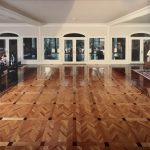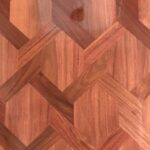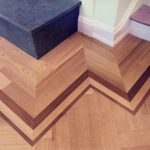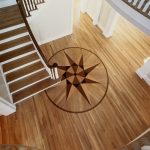Most homeowners would agree that hardwood flooring is beautiful and an excellent way to add value/elegance to your home. What can be confusing to some new homeowners who have never had hardwood floors installed or refinished is the types of wood flooring options. What types of hardwood floors are available? Which species of wood makes the most sense for your home and needs?
This article will discuss the different types of hardwood floors and wood species homeowners can choose; and what factors make sense to consider when choosing a hardwood flooring option for a residential home.
Covering the Basics
When reviewing the options for your hardwood flooring solutions, there’s a critical difference all homeowners should keep in mind. There is solid hardwood flooring, and then there is engineered hardwood flooring.
Traditional solid hardwood flooring (most commonly called hardwood flooring) is real wood sourced and milled from a single piece of wood, selected from a specific tree species. It is not synthetically crafted in any way, and hardwood flooring has been admired and trusted for hundreds, in not thousands of years. Custom wood floors are a significant design feature of any beautiful home.
In recent decades, advancements in engineering, materials, and production methods have allowed manufacturers to produce high-quality engineered hardwood flooring that replicates the look of solid hardwood.
Engineered wood planks have a top layer made of solid hardwood with sublayers made of plywood that the homeowner will never see. Traditional solid hardwood flooring and engineered hardwood can be refinished, stained, and last for decades upon decades with proper care.
Engineered hardwood is cheaper than most solid hardwood flooring options. However, homeowners will choose to use engineered hardwood in areas of the home that are below grade. Below grade, meaning below ground level, usually a basement or rec room.
There are areas of the house that are not suitable for solid hardwood floors because of the environment or architectural features. For instance, you should not install solid hardwood over a concrete slab or radiant heating.
Learn About Five Hardwood Flooring Installation Mistakes No One Should Make!
Choosing a Hardwood Species
There are multiple types of hardwoods worldwide. For this blog’s purposes, we’re going to discuss some of the more popular wood choices that homeowners prefer for hardwood flooring options.
When a homeowner works with a professional hardwood flooring company, it’s the business’s mission to match the homeowner’s tastes and flooring desires to real-world solutions. All hardwoods are graded on a scale called the Janka scale. The higher the number on the Janka scale, the harder and more durable the wood is; its durability must be considered alongside its visual appearance.
Popular Hardwood Species for Flooring
Oak Wood – Red Oak and White Oak
Oak is by far the most popular flooring option around the world. It’s economical, versatile, and beautiful. There are two primary varieties of oak wood, which is white oak and red oak. Both white oak and red oaks are very durable, ranking on the higher-end of the Janka scale.
Red oak is the more common of the two, and its wide-ranging warm color tones and durability have kept it a top choice for many homeowners.
White oak wood is slightly harder than red oak, making it suitable for high-traffic areas. Not to mention it’s smooth and gentle on the eyes; it’s is one of the most elegant hardwood flooring solutions a homeowner can choose. White oak will take stain better than red oak, which is why it’s one of the most popular and versatile hardwood flooring options we use today.
American Walnut Wood
Walnut hardwood flooring is some of the richest, most profound, “chocolate-like” coloring and grain patterns you can put in your home. However, as beautiful as American walnut is, it’s not meant for families with pets, children, and lots of foot-traffic; it’s a very soft wood.
People who love American walnut hardwood flooring usually select it when they want something sophisticated and slightly dramatic; it’s often installed as border detail or an accent strip. American walnut is amongst our favorite woods and looks fantastic in a formal dining room, office or study.
American Cherry Wood
Renowned for its beautiful rich brown and red patina, American cherry wood has been a premium choice for hardwood flooring for hundreds of years. It’s a very soft wood, and it’s not recommended to be installed in a home with lots of children or pets; it’s best to install cherry wood floors in areas that don’t see high-foot traffic. Homeowners will rarely install American cherry wood throughout their entire home, and it’s best left to low-traffic areas such as a study or formal dining room.
The patina that homeowners desire from American cherry wood also takes some time to develop, and the wood is slightly pink at first. We recommend American cherry wood to homeowners who view it as a long-term investment and are willing to wait for it mature. We love how it looks with an oil-based Mahogany stain!
Hickory Wood
Hickory wood floors are very durable, dense, and versatile. Hickory wood gives you great lights and darks in the natural coloring of the planks. Some of the world’s most sought Hickory wood is sourced in the Appalachian region of New York and Pennsylvania.
We recommend Hickory wood floors to homeowners that desire a beautiful rustic, farmhouse style interior design. Picture a sunken family room in a cabin on a lake – that’s the ideal scenario for a gorgeous Hickory wood floor.
Maple Wood
Maple is one of the hardest woods out there, ranking at the top of the Janka scale, so it’s suitable for almost any room with consistent foot-traffic. Maple is a visually appealing/attractive wood with blonde/creamy hues accompanied by some occasional dark streak in the grain.
Maple is best suited for contemporary homes that feature natural light, modern appliances, and beautiful stonework/countertops. Maple is vulnerable to fluctuations in humidity as it tends to shrink and swell; a climate-controlled household will suit maple flooring best. We love how maple flooring looks with a water-based polyurethane stain rather than oil – an oil-based stain will turn the wood yellow.
To learn more about wood species, types of hardwood floors, hardwood floor restoration, or hardwood floor refinishing, please contact us.







